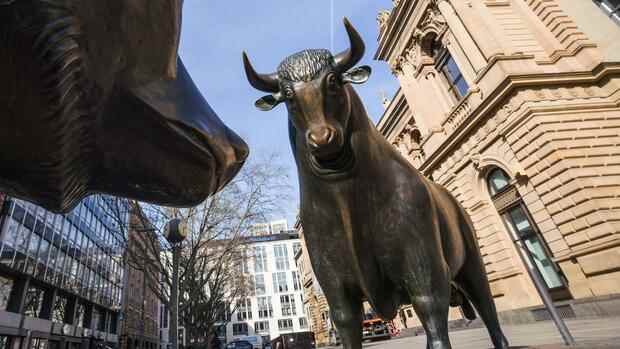It is a market phase characterized by great uncertainty.
(Photo: dpa)
Dusseldorf The stock market world is divided into two. In Germany, investors remain skeptical about the rise in prices and are hedging their positions. At the same time, they are now quite heavily invested.
In the USA, on the other hand, the mood of investors is rising and so is their investment rate. At the same time, skepticism about the further development of share prices is disappearing. According to Stephan Heibel, after evaluating the Handelsblatt survey Dax-Sentiment and other indicators: “We have two opposing positions on the stock exchanges in Germany and in the USA.”
The more important conclusion is: “Due to the very high investment rate, further positive news is required for the rally to continue.” In the past few weeks, Heibel had always spoken of a surprise potential on the upside and was right. The leading German index has risen by more than 14 percent since the end of September, an increase of over 1,700 points.
The sentiment expert cannot give a precise explanation as to why the stock market world is currently divided in two. The current news situation is too opaque for that. “The stock markets are at an important fork in the road,” says Heibel. “Just a little hope would be enough to push stock markets further north.”
Top jobs of the day
Find the best jobs now and
be notified by email.
For example, weaker economic data could soon allow the US Federal Reserve to slow down its rate hikes. Hope can also come from China. Foreigners can now have Biontech vaccines injected there. Possibly a first step towards an end to the zero-Covid policy in the Middle Kingdom, which is harmful to the global economy.
Conversely, this also means that negative reports, for example in terms of inflation or from China, could mean an end to the current rally.
Current survey data
The Dax went through a roller coaster ride in the past week. After a hopeful start before the US Federal Reserve meeting, the sell-off followed in the middle of the week due to Fed Chair Jerome Powell’s hard line. Last Friday it went up again, the weekly plus was 1.6 percent.
The participants in the sentiment survey were not comfortable with this rollercoaster ride of the past week. Sentiment slipped to minus 0.3 after plus 0.1 in the previous week. The current minus value joins the dominating despondency of the entire year. Uncertainty also remains with a value of minus 1.8.
With a value of minus 0.3, the future expectation shows a neutral constitution. There is a willingness to invest. This value climbed to plus 2.5. The only thing missing is a clear direction.
Because according to chart technology, the leading German index is about to have decisive trading days. Will the Dax fall back into the bearish trend of the past few months after the October rally? Or will the leading index break out to the upside? Then the bear market would be over.
The Euwax sentiment of private investors has fallen to minus eight. Obviously, retail investors are hedging against another sell-off at the top of the bear market trend. Because negative values in the Euwax sentiment mean more put than call products in the portfolios of private investors.
The put/call ratio of the Frankfurt derivatives exchange Eurex, where investment professionals trade, has risen to 2.3. Institutional investors are also increasingly buying put protection.
In the USA, on the other hand, the propensity to hedge against falling prices has declined. The put/call ratio of the Chicago futures exchange CBOE shows only an average value.
The investment ratio of US fund managers has risen from 43 to 54 percent, so at least these investors are back on the road to normality. For most of this year, the investment rate was well below 60 percent. Historically, however, an investment rate of between 60 and 80 percent is the norm.
Even a little hope would be enough to push the stock markets further north. Stephan Heibel, sentiment expert
And US private investors are also shedding their fears, the bull/bear ratio has risen to just minus 2.3 percent. 31 percent of investors are bulls again, so expect prices to rise. The proportion of those who are pessimistic has fallen to 33 percent. The “fear and greed indicator” of the US markets, calculated using technical market data, shows moderate greed with a value of 58 percent.
There are two assumptions behind surveys such as the Dax sentiment with more than 7,500 participants: if many investors are optimistic, they have already invested. Then only a few are left who could still buy and thus drive prices up.
Conversely, if investors are pessimistic, the majority of them have not invested. Then only a few can sell and thus depress the courses.
Do you want to take part in the survey? Then let yourself be automatically informed about the start of the sentiment survey and register for the Dax sentiment newsletter. The survey starts every Friday morning and ends on Sunday afternoon.
More: Investors make these ten mistakes from the point of view of stock market psychologists

